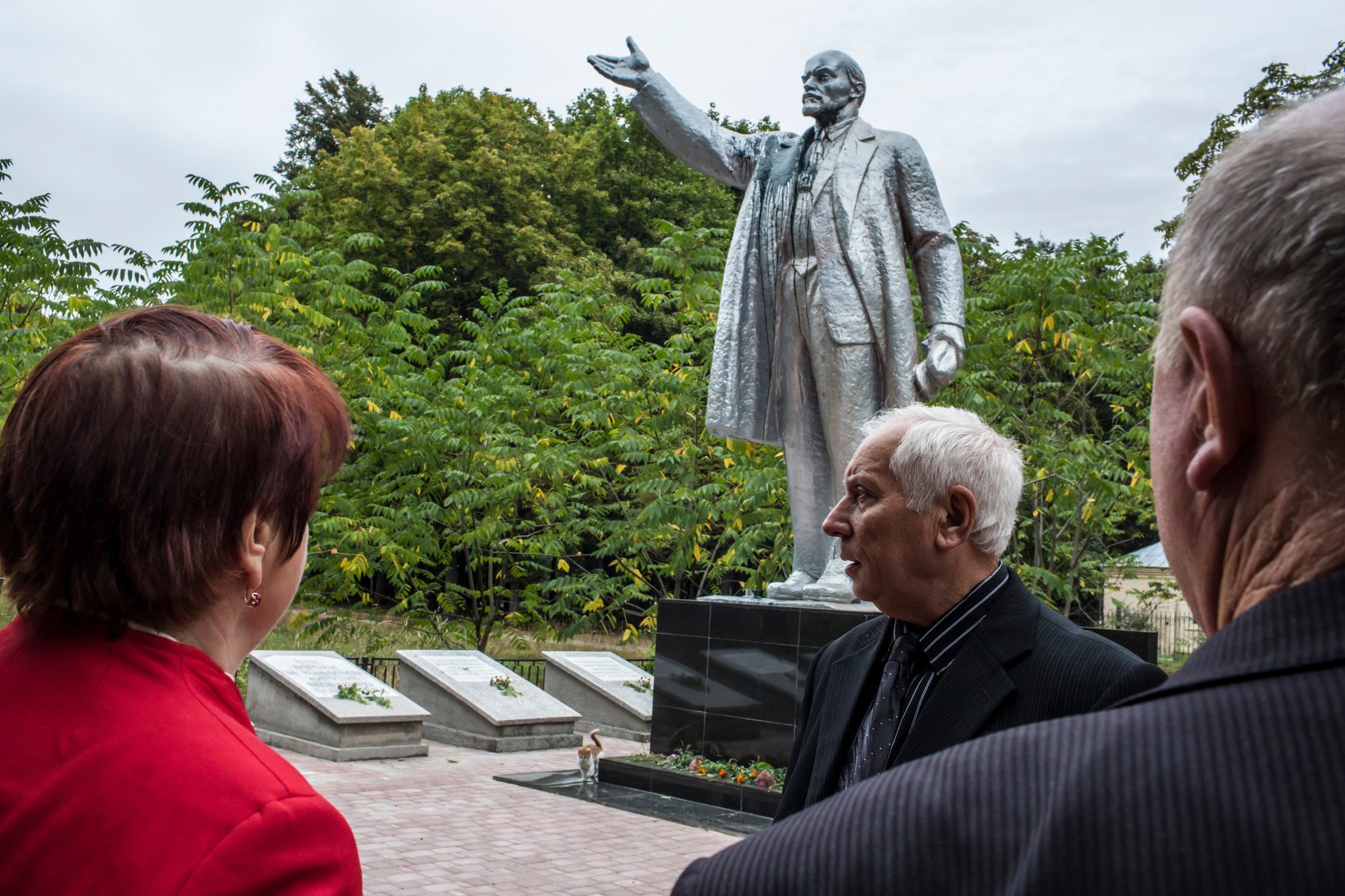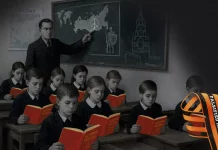
A young policeman knocked on Ivan M. Papchenko’s front door one recent afternoon, brandishing a complaint from the National Memory Institute of Ukraine and demanding to know why this village had resurrected Lenin.
Semyonovka stood accused of being a “de-communization” scofflaw.
Mr. Papchenko, the local Communist Party chief, refused to concede that anything was remotely amiss. The Lenin statue, he said, was long gone from the town’s Red Square. The expanse of naked asphalt, even more dreary without the statue, does not exactly conjure up the grand Moscow version.
Instead, Semyonovka’s 12-foot, silver-colored Lenin with his right arm extended had been propped back up on a plinth tucked away in a leafy park. “We want to preserve this small corner of Soviet history,” said Mr. Papchenko, 67, a stout former school principal whose multiple gold molars attested to his own life in the U.S.S.R. “If they destroy all signs of the past whenever the ideology changes, what will be left?”
Ukraine has embarked on a quest for a new identity, a fallout from the hybrid war that President Vladimir V. Putin of Russia unleashed in early 2014. The country is trying to separate itself from the long historical baggage of the Russian and Soviet empires.
Vladimir Vyatrovich, 38, a historian and the head of Ukraine’s National Memory Institute, predicted somewhat rashly that if the effort succeeded in Ukraine, it would cause fateful reverberations next door.
Russia’s modern identity basically started with the 17th-century invasion of what is now Ukraine, Mr. Vyatrovich said. “So the moment when Ukraine finally manages to become a totally independent state will also be the moment when Russia’s imperialistic identity ends.”
Mr. Vyatrovich helped push four “memory laws” through Parliament last spring.
The laws dumped the Soviet traditions for commemorating World War II, opened up what K.G.B. secret police archives remained in Ukraine and sought to rehabilitate certain Ukrainian independence fighters whom Moscow had long pilloried as Nazi collaborators.
The fourth law, the one with arguably the most tangible effect nationally, required the removal of all names and symbols linked to the Communist or Nazi past.
A fight has emerged over the Communist symbols, however, not unlike that between supporters and opponents of the Confederate battle flag in the southern United States.
For opponents, the Lenin statues might as well be Russian agents.
“A concentration of Lenin statues is a sign of danger where ‘polite people’ might appear,” Mr. Vyatrovich said in an interview. Polite people is the Russian euphemism for the anonymous Russian Special Forces troops who seized Crimea.
His allies argue that the statues clash with the democratic values that Ukrainians want to instill in the next generation.
Fans of the Communist-era symbols tend to be older Ukrainians who still long for the Soviet era. They and others argue that Ukraine faces far more severe problems, like an economic nose dive, that should take precedence, and furthermore that the state should not mandate historical interpretation.
“They behave like Bolsheviks: ‘We have to wipe out the past!’ ” said Georgiy V. Kasyanov, a historian and education reform activist. “They think the Soviet legacy can be destroyed by destroying statues of Lenin or by renaming streets, which is false. They are wrestling with ghosts.”
Critics call destroying the symbols a sop to the small but vocal right-wing movement. The main font of a new identity, they argue, should be a definition of citizenship that incorporates Tatars, Jews, Poles and others ostracized for centuries.
Lenin statues and Lenin streets used to be ubiquitous. “This was Leninland,” Mr. Vyatrovich said, with 5,500 statues in Ukraine when the Soviet Union collapsed in 1991.
By the time of the Maidan uprising in Kiev that toppled the pro-Russian government in February 2014, Ukraine was down to about 1,300 Lenins, he said. Five hundred more have come crashing down since.
Many towns hit on the idea of selling the statues — often bronze — for scrap and paying wage arrears or buying new streetlights or even, occasionally, armored cars for volunteer fighters.
Some efforts proved more successful than others. One of the largest Lenin statues in Ukraine, in the city of Kharkiv, was dismembered.
Activists hoping to pay for military equipment for volunteers fighting separatists in eastern Ukraine tried to auction it off piecemeal online, including an ear that weighed nearly 80 pounds. The sellers rue the day they rejected a $2,000 offer for the ear as too low — they never got another bid, according to one organizer.
Apart from the statues, 910 cities and towns need new names, as do tens of thousands of streets.
Some places have balked at rebranding. Dnipropetrovsk, for example, Ukraine’s third-largest city, was named in 1926 in honor of Grigory Petrovsky, a now forgotten leader of the Russian Revolution. It became famous as the Soviet Union’s “rocket city” with that name and wants to keep it.
Each City Hall has until Nov. 21 to make the changes. If they do not, Parliament will do it for them by Feb. 21. Many towns established websites where residents can vote on new names.
In Kiev, a television comedy show suggested the modern landmark Moscow Bridge be renamed the Not Moscow Bridge.
City Hall in Kiev said it would pull down about 100 statues.
In the southern port of Odessa, one sizable Lenin statue was recast as Darth Vader, complete with a Wi-Fi router in his headgear.
In Semyonovka, in northeastern Ukraine some 10 miles from the Russian border, about 20 street names need changing. They have not gotten very far. One proposal would rename Collective Farm Street after Maxim Grachov, a 29-year-old who died fighting the separatists.
In some ways, Semyonovka is a typical Ukrainian town that time forgot. Farmers clop along on horse-drawn carts. Dozens of little log cabins grace the unpaved side streets. The toilet for the squat apartment block that houses the Communist Party office is in an outhouse.
Semyonovka’s Lenin statue survived its initial removal intact, lifted by a crane and carted off Red Square.
“I wept,” said Ivan Kovalenko, 69, a retired engineer. “The West said it could not defeat us with weapons, so it decided to destroy us from within with prostitution and democracy.”
An outcry ensued, at least among older people who remember when Semyonovka had 15 thriving factories and 15,000 people. Most of the factories are shuttered, and the population has shrunk to around 9,000.
Did bringing down Lenin suddenly make their lives better, statue lovers have asked bitterly. City Hall initially quieted the debate in April 2014 by erecting Lenin in the secluded spot. Then the issue came roaring back to life along with the memory laws.
Members of the committee assigned to deal with the Communist symbols started hearing from anonymous phone callers who growled that if the committee did not remove the statue, someone else would.
Still they resisted.
And continue to. A woman wearing a navy blue bathrobe, hearing why foreigners were visiting recently, came bowling over, shaking her fist.
“You think Lenin’s statue is the biggest problem we have?” she yelled. “Try living on a pension of $40 a month. How much do you live on? At least Lenin organized the electrification of this country. Pretty soon we will be back to the conditions that existed before Lenin.”
Young residents shrug off the statue’s fate. The stalwarts, however, plotted to save it. They hit on the idea of historical value, declaring their silvery Lenin part of a small local history museum.
The National Memory Institute will not have it, Mr. Vyatrovich said. “If it is in a public place, it is still totalitarian propaganda.”
Alisa Sopova contributed reporting.
A version of this article appears in print on October 28, 2015, on page A9 of the New York edition with the headline: A Fight to Save Beloved, and Illegal, Communist Symbols in Ukraine.





